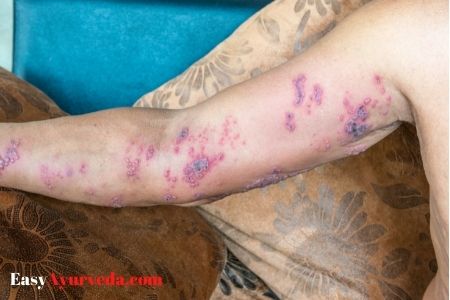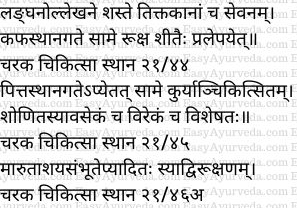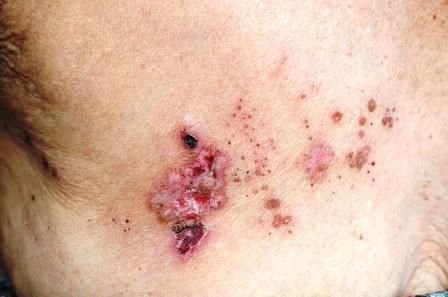Visarpa: Causes, Types, Treatment, Medicines
Article by Dr Raghuram Y.S. MD (Ay)
Visarpa is a condition which has often been compared to erysipelas and herpes due to similarity in presentation. Since erysipelas doesn’t have elevated blisters we can rule it out. But most of the types of visarpa mimic erysipelas. In few types of erysipelas we can find symptoms similar to herpes zoster.
Table of Contents
Classification of Visarp
| Sl No | Name of Visarpa | Doshas involved |
| 1 | Vataja | Vata |
| 2 | Pittaja | Pitta |
| 3 | Kaphaja | Kapha |
| 4 | Sannipataja | vata, pitta and kapha |
| 5 | Agneya | Vata-Pitta |
| 6 | Granthi | Vata-Kapha |
| 7 | Kardama | Pitta-Kapha |
2. Sthana Bheda / Based on location of the disease
Depending on the site in which the disease is located, Visarpa is divided into 3 types –
- Bahishrita – located in the superficial tissues
- Antahshrita – located in the deeper tissues
- Ubhayashrita – located both in the superficial and deeper tissues
Types of Visarpa
Agneya Visarpa – In this ‘agni dagdhaha iva sphotaha’ i.e. blisters as if burnt by fire (blisters occurring post burning) occur along with associated symptoms which depict high level of inflammation. It is caused by vitiated Vata and Pitta and is associated with fever, vomiting, fainting, diarrhoea, thirst, giddiness, joint pains etc symptoms.

Granthi Visarpa – is caused by dual vitiation of kapha and vayu. This contaminates the skin, ligaments, tendons and muscle tissue and form blisters. The blisters are red and painful. The blisters are elongated or small or rounded or hard or stout in appearance. The blisters are in chains and arranged in the form of beads. This visarpa is associated with fever, pain, cough, dyspnoea, vomiting, giddiness, discolouration, fainting etc symptoms.
Kardama Visarpa – presents as yellow or red coloured blisters which are unctuous, black, dirty, swollen, heavy, suppurated inwards and hot in nature. Since they are filled with fluids they rupture immediately when touched. They emit foul smell. They are caused by dual vitiation of pitta and kapha and associated with fever, headache, feeling as if body is coated, bone pains, excessive sleep, thirst etc symptoms.
Kshataja Visarpa – It is formed due to combined impact of injury and vitiated Vata, rakta and pitta. The blisters resemble that of horse gram in size and shape, has red or blackish brown colour and is associated with fever, pain, burning sensation, diarrhoea, tiredness, vomiting etc symptoms.
These Visarpas closely resembles erysipelas, herpes zoster, blisters due to burns and cutaneous radiation syndrome. This Visarpa is said to be one of the dreadful conditions and difficult to treat. In this perspective we can consider the complicated course of the above said conditions.
Bullous pemphigoid and Epidermolysis bullosa have close resemblance with Kardama Visarpa.
Kshataja visarpa includes blisters occurring due to external causes like Friction and rubbing, chemical exposure, contact dermatitis, exposure to heat, fire and sun, allergic reactions, injuries etc.
Bahya Abhyantara Bheda / External and Internal types
This should not be confused with the above mentioned type. The above mentioned type is all about in which tissues the disease is located. Bahya Abhyantara Bheda means whether the disease is located outside or inside the body. Again the tissues located outside and inside the body shall be embedded in this type because the structures (organs) of the outer and inner side of the body are also made up of the same tissues. This classification is considered here because the symptoms of visarpa located inside the body (affecting the interior organs and the tissues making them) are detailed by Master Charaka.
Abhyantara Marga Ashrita Visarpa Lakshana (symptoms of visarpa located inside the body)
- Injury to the vital organs / structures
- Loss of consciousness
- Friction within and between the internal structures / organs
- Excessive thirst
- Abnormal expression and discharge of body’s natural urges like feces, urine, fart etc
- Quick deterioration of digestive fire
These symptoms are present along with the general symptoms of visarpa.
Bahya Marga Ashrita Visarpa Lakshana (symptoms of visarpa located outside the body)
If the above mentioned symptoms of visarpa located inside the body are absent in visarpa and if the other general symptoms of visarpa are manifested, mainly outside the body, it should be diagnosed as bahya visarpa.
Note – There are three roga margas explained in Ayurveda, the three pathways of manifestation of disease. Bahya and Abhyantara are two types. There is another roga marga – madhyama roga marga, which includes vital organs and structures, bones and joints of the body.
Classification for treatment purposes
The below mentioned classifications are not actual classifications to be precise. Here it is mentioned as classifications of visarpa based on the explanation given in Charaka Chikitsa chapter 21 since these classifications help in knowing about the morbid doshas, their association with ama, their location in specific doshic regions of the body and further help in proper planning of treatment for the same.
4. Sama Dosha Sthananusara Bheda / Based on location of ‘dosha associated with ama’
Kapha sthana gata sama dosha – In visarpa, if doshas associated with ama are located in the seats of kapha, langhana and vamana shall be administered. Bitter tasting herbs shall be used in the form of medicines and food. Dry and cold anointments shall be applied externally.
Pitta sthana gata sama dosha – In visarpa, if doshas associated with ama are located in the seats of pitta, langana, vamana and bitter herbs shall be administered. Bloodletting and therapeutic purgation are ideal as specific treatment choices for pitta predominant visarpa.
Vata sthana gata sama dosha – In visarpa, if doshas associated with ama are located in the seats of vata, langana shall be administered first.
Benefits of knowing this classification are explained in the above three contexts.
Read – Bitter Taste – Qualities, Health Benefits, Side Effects
5. Urdhwa bhagagata, Madhya bhaga gata & Adhah bhaga gata Visarpa
We don’t find this classification too explained in the treatises. But here this classification is considered from treatment perspective, just as the above said (no 4) classification.
This is a related classification of the above (no 4) said.
- Kapha sthana i.e. seats of kapha are located in the upper part of the body (urdhwa bhaga) i.e. visarpa located in the upper part of the body are actually in the seats of kapha
- Pitta sthana i.e. seats of pitta are located in the middle part of the body (madhya bhaga) i.e. visarpa located in the middle part of the body are actually in the seats of pitta
- Vata sthana i.e. seats of vata are located in the lower part of the body (adhah bhaga) i.e. visarpa located in the lower part of the body are actually in the seats of vata
6. Sama and Nirama Visarpa / Visarpa in which doshas are either associated with ama or not associated with ama
This classification too has not been specified in the treatises. In the 4th classification above the location of ‘sama dosha’ i.e. dosha associated with ama being located in seats of kapha, pitta or vata and the management accordingly has been mentioned. Therefore in the initial line of treatment, the assessment of involvement of ama or its absence is very essential. This explanation also shows that ama is invariably associated in the disease in the earlier stages, be it any type of visarpa. We can see that langhana i.e. treatments which bring about lightness in the body and rukshana – treatments which cause dryness of ama are mentioned in doshas located in kapha, pitta or vata seats. The other treatments and medicines and also external administration of therapies shall be done only after the ama has been dealt with i.e. in nirama stage of the disease i.e. when doshas involving in the pathogenesis of visarpa get devoid of ama. As already said, the benefits of knowing this classification is from treatment perspective.
Prognosis Sadhya Asadhyata
Visarpa caused by single dosha i.e. vataja, pittaja and kaphaja types are curable.
Among the visarpa caused by two doshas, agni visarpa (vata-pitta) and kardama visarpa (pitta-kapha) can be cured if they are not associated with complications and if the disease has not afflicted to the vital organs and tissues, blood vessels, ligaments, muscles and fluids of the body provided they are promptly treated and treatment continued till the disease goes away. If these conditions are not treated properly they may kill the person just like the poison of a snake.
Granthi Visarpa (vata-kapha) should be treated as soon as possible. Granthi visarpa shall not be treated if associated with complications.
Sannipataja Visarpa (caused by all three doshas) is not curable since it has spread over into all the tissues, has tendency to form and spread quickly and the treatment strategies are mutually antagonistic amongst the doshas.
Based on deep or superficial tissue involvement:
The visarpa located in the superficial tissues is treatable with external therapies like anointments and showering of medicinal liquids. The visarpa located in deeper tissues can be cured by administering cleansing therapies in the form of panchakarma treatments as and when required and complemented with external therapies if needed. This classification also helps in determining the prognosis of the disease and selecting the condition for treatment or to reject it if it is beyond the scope of treatment.
- Visarpa located in superficial tissues is said to be easily curable
- Visarpa located in deeper tissues is curable with difficulty
- Visarpa located both in internal and external tissues is either extremely difficult to cure or incurable
Read – How To Make Prognosis Of Disease According To Ayurveda?
Treatment principles
Principles of treating Visarpa:
Visarpa vis-à-vis blisters (erysipelas, herpes, dermatitis herpetiformis etc) should be promptly attended by the below said measures –
- Langhana – fasting or lightening measures (to rectify metabolism, to digest ama or immature essence of digestion in circulation which is toxic to all cells)
- Rukshana – to remove excess and unnecessary fluidity in the body
- Virechana – therapeutic purgation for expelling the morbid pitta and reduce the inflammatory process in the body
- Vamana – therapeutic emesis for expelling the vitiated kapha from the body and to reduce excess kleda or unwanted fluidity and blocks in the body
- Lepa – application of medicinal pastes to hasten re recovery process and to heal the lesions (blisters)
- Seka – stream pouring or sprinkling of medicinal fluids over the blisters to heal them
- Raktamokshana – bloodletting to remove the contaminated blood, also heals infections
- Avidahi ahara – non-corrosive foods
Kusht Visarpa difference
Differentiation of Kushta from Visarpa:
Some Vaidyas are of the opinion that Kushta affects skin whereas Visarpa can be internal, external or both.
Modern correlation
Visarpa can be correlated with Herpes. It is characterized by suppurative epithelial inflammatory condition. It can be both internal or external.
Some Vaidyas correlated it as Inflammatory suppurative degenrative cancerous skin condition.
Kardama Visarpa is correlated with cancer.
Lepa Herbal pastes for Visarpa
Panchatwagadi lepam – application of Shatadhauta Ghrita (ghee washed 100 times in water) with Panchavalkala churna i.e. powders of Nyagrodha (Ficus bengalenesis), Udumbara (Ficus glomerata), Ashwatta (Ficus religiosa), Parisha (Thespesia populanea) and Plaksha (Ficus lacor) highly useful in alleviating burning sensation and Agni Visarpa
Nyagrodhadi Lepam – Paste of roots of Nyagrodha (Ficus bengalenesis), Gunja (Abrus precatorius) and Kadali garbha (pulp of plantain stem mixed in shatadhouta ghrita is highly beneficial in Agni visarpa
Shireeshatwagadi lepam – The paste made by mixing the powder of bark of Shireesha (Albizia lebbeck) in Shatadhouta ghrita is beneficial in Kardama Visarpa
Laghupanchamuladi Kwatha – Decoction of 5 lesser roots i.e. Shalaparni (Desmodium gangeticum), Prishniparni (Uraria picta), Brihati (Solanum indicum), Kantakari (Solanum xanthocarpum) and Gokshura (Tribulus terrestris) and Yava valkala (bark of barley) is used for seka (sprinkling) and pana (intake)
Guduchyadi Kashayam
Patoladi kashayam
Bhunimbadi Kwatha / Kashayam – Decoction of Bhunimba (Andrographis paniculata), Vasa (Adhatoda vasica), Katuki (Picrorrhiza kurroa), Patola patra (leaves of pointed gourd), Amalaki (Emblica officinalis), Haritaki (Terminalia chebula), Bibhitaki (Terminalia bellirica), Chandana (sandal wood), Nimba twak (bark of neem) is a good remedy for visarpa and visphota.
Importance Of Ama And Langhana In The Treatment Of Visarpa
Association of ama with visarpa causing doshas and administration of langhana
Visarpa, which is often compared to herpes or erysipelas, is one such disease wherein Master Charaka has stressed upon the administration of langhana in the initial phase of the disease, since it is this phase of any disease wherein we can find the association of ama. Amongst the treatment principles of visarpa, Master Charaka emphasizes on the point ‘if ama is present…’. This gives the physicians treating visarpa a mandatory rule to look for ama before treating visarpa.
Though visarpa manifests in different ways, its display will most often than not be external. Visarpa would manifest in three ways in the external tissues, internal tissues or in both. Likewise it may get manifested in the external pathway which includes tissues, including skin and internal pathway including organs. Even the visarpa having internal manifestation the lesions would be seen externally. So it is important to look at Visarpa from ‘gut perspective’. Obviously the treatment of visarpa starts from addressing the root of pathology in the stomach, by managing ama at gut level and its association with doshas. It is equally important to access the region of the body in which the doshas associated with ama are located. This would help in proper formatting of treatments.
Read – Association Of Ama With Doshas, Tissues And Waste Products
Treatment of Sama Doshas (doshas associated with ama) located in the seats of doshas
1. Sama doshas located in the seats of kapha
When doshas associated with ama are located in the seats of kapha i.e. upper part of the body and the structures located therein, the below mentioned treatments should be done on priority basis –
- Langhana – includes fasting and other treatments which induce lightness in the body.
- Vamana – shall be done after ama has been removed / destroyed after administration of langhana
Tikta rasa – herbs tasting bitter shall be used as medicines and for preparing foods.
Lepa – anointments which are dry and cold (prepared with herbs which are cold in potency and can induce dryness shall be used. Lepas too shall be administered after dissolution of ama.
Read – Lepa Kalpana: Ayurvedic Dosage Forms For External Application
2. Sama doshas located in the seats of pitta
When doshas associated with ama are located in the seats of pitta i.e. middle part of the body and the structures located therein, the same treatments mentioned above i.e. langhana, vamana and tikta rasa shall be used.
Apart from these, pitta specific treatments shall be done –
- Raktamokshana – bloodletting
- Virechana – therapeutic purgation
3. Sama doshas located in the seats of vata
When doshas associated with ama are located in the seats of vata i.e. lower part of the body and the structures located therein, virukshana should be first administered – i.e. medicines which induce dryness by depleting ama should be used to induce dryness in the seats of vata.
Sanskrit Verses

Read – Ama Chikitsa: Treatment For Ama And Saama Conditions
Summary
Here we learn that doshas associated with ama may be localized in the seats of kapha, pitta or vata and produce visarpa related to those seats, involving related doshas and associated ama. So, the doshas associated with ama located in the seats of doshas cause visarpa. Before tackling these visarpa causing doshas, the ama associated with the doshas shall be properly dealt with. To dissociate ama from doshas, langhana is the best remedy.
Langhana is of 10 types. Among these, the four types of cleansing therapies i.e. emesis, purgation, decoction enemas and errhines are not preferred since they are not administered in the presence of ama. Among the other 6 types of langhana, upavasa i.e. fasting is usually preferred for producing lightness in the body and to destroy ama. The choice of langhana measures or fasting shall be chosen in accordance to the strength of the disease and diseased and the quantum of ama associated with doshas.
Read – How To Do Fasting? A Step By Step Guide For You
Langhana is contraindicated in vata disorders and in pathological increase of vata. But in presence of ama with vata, langhana shall be administered for a shorter duration, in milder form, until the ama gets dissociated. Once ama has been detached from its association with vata, langhana shall be immediately stopped. The same rule is applicable for ama associated with pitta or kapha, or when ama is located in the seats of pitta or kapha, but the rule should be strictly followed and langhana should be stopped without delay in case of ama associated with vata or ama associated doshas located in the seats of vata.
We can see that rukshana has been mentioned as treatment of choice for sama doshas located in seats of vata. Langhana is not mentioned here. In spite of this, as explained above langhana shall be selectively administered. Ruksha / dryness is anyways one of the properties of langhana. Vamana and Virechana mentioned in the context of sama doshas located in kapha and pitta seats are also forms of langhana. But langhana has specifically mentioned before these therapies in each of these contexts. This means to tell that langhana in the form of fasting or any other form as per the judgment of the physician shall be administered.

Sahasrayogam Kashayams for Visarpa
1. Visarpahara Kashayam
Ref – Sahasrayogam, Kashaya Prakaranam, 49
a. Patoladi Kashayam
| Ingredients | Botanical Name | Method of using | Indications |
| Snake gourd | Trichosanthes dioica | The decoction prepared with these ingredients should be served fresh | 1. Herpes |
| Daruharidra | Berberis aristata | ||
| Neem | Azadirachta indica | ||
| Katukarohini | Picrorhiza kurrooa | ||
| Trayantika | Gentiana kurroo | ||
| Licorice | Glycyrrhiza glabra | ||
| Vasa | Adhatoda vasica | ||
| Musta | Cyperus rotundus |
b. Mustadi Kashayam
| Ingredients | Botanical Name | Method of using | Indications |
| Musta | Cyperus rotundus | The decoction prepared with these ingredients should be served fresh | 1. Herpes of vata origin |
| Neem | Azadirachta indica | ||
| Patola | Trichosanthes dioica | ||
| Devadaru | Cedrus deodara | ||
| Turmeric | Curcuma longa | ||
| Raisins | Vitis vinifera | ||
| Bala | Sida cordifolia | ||
| Ginger | Zingiber officinale |
c. Trayantadi Kashayam
| Ingredients | Botanical Name | Method of using | Indications |
| Trayanti | Gentiana kurroo | The decoction prepared with these ingredients should be served fresh | 1. Herpes of pitta origin |
| Utpala | Nymphaea stellata | ||
| Dhanvayasa | Alhagi camelorum | ||
| Coriander | Coriandrum sativum | ||
| Bhunimba | Andrographis paniculata | ||
| Ushira | Vetiveria zizanioides | ||
| Hrivera | Pavonia odoraa |
d. Shreshtadi Kashayam
| Ingredients | Botanical Name | Method of using | Indications |
| Shreshta | Fruits of – Terminalia chebula Terminalia bellerica Emblica officinalis | The decoction prepared with these ingredients should be served fresh | 1. Herpes of kapha origin |
| Neem | Azadirachta indica | ||
| Patola (Snake gourd) | Trichosanthes dioica | ||
| Pippali | Piper longum |
2. Kulakadi Kashayam
Ref – Sahasrayogam, Parishishta Prakaranam, 80
| Ingredients | Botanical Name | Method of using | Indications |
| Snake gourd | Trichosanthes dioica | The decoction prepared with these ingredients should be served fresh | 1. Herpes with pain 2. Vomiting 3. Burning sensation 4. Nausea 5. Thirst |
| Vasa | Adhatoda vasica | ||
| Kirata | Swertia chirata | ||
| Neem | Azadirachta indica | ||
| Katuki | Picrorhiza kurrooa | ||
| Bibhitaki | Terminalia bellirica | ||
| Haritaki | Terminalia chebula | ||
| Indian Gooseberry | Emblica officinalis | ||
| Sandalwood | Santalum album | ||
| Guggulu | Commiphora mukul |
3. Nannaryadi Kashayam
Ref – Sahasrayogam, Parishishta Prakaranam, 81
| Ingredients | Botanical Name | Method of using | Indications |
| Krishna Sariva | Hemidesmus indicus | The decoction prepared with these ingredients should be served fresh | 1. Herpes |
| Sandalwood | Santalum album | ||
| Ushira | Vetiveria zizanioides | ||
| Licorice | Glycyrrhiza glabra | ||
| Ambujasya kinjalka / Kamala kesara | Stigma of Nelumbo nucifera | ||
| Manjishta | Rubia cordifolia | ||
| Turmeric | Curcuma longa | ||
| Haritaki | Terminalia chebula |
4. Chunda Tavidvamadi Kashayam
Ref – Sahasrayogam, Parishishta Prakaranam, 82
| Ingredients | Botanical Name | Method of using | Indications |
| Bhunimba | Andrographis paniculata | The decoction prepared with these ingredients should be served fresh with rice gruel | 1. Herpes |
| Punarnava | Boerhavia diffusa | ||
| Ginger | Zingiber officinale | ||
| Duralabha | Fagonia cretica |
5. Trayantyadi Kashayam
Ref – Sahasrayogam, Parishishta Prakaranam, 111
Read more here – Trayantyadi Kashayam – Benefits, Dose, Side Effects And Ingredients
Method to Use – served fresh admixed with ghee
Other yogas from Sahasra Yoga text book for Visarpa
1. Visarpahara Kashaya
2. Tiktaka Ghrita
3. Mahatiktaka Ghrita
4. Vrisha Ghrita
5. Panchavalkadi taila
6. Chandanadi Taila
7.Vrana bhairava Taila
8. Khandasama choorna
9. Nalpamaradi Taila
Pathya apathya – Yogaratnakara
Wholesome herbs, diet and habits
Purgation, emesis, fasting, blood letting, old barley, wheat, Foxtail millet, rice grown in sixty days, green gram, lentil, bengal gram, pigeon pea, meat of animals of desert-like land, butter, ghee, raisins, pomegranate, bitter gourd, sprouts of Goat willow, pointed gourd, Indian gooseberry, acacia, Indian rose chestnut, raisins, lebbeck, camphor, sandalwood & sesame application etc.
Unwholesome herbs, diet and habits
Exercise, day sleeping, sexual intercourse, strong breeze, anger, grief, suppression of vomiting etc. urges, intake of foods & drinks that are heavy to digest, garlic, horse gram, black gram, sesame, meat of animals of desert-like land, sudation therapy, substances that cause burning sensation, salty, sour & pungent substances, alcohol, excess exposure to sunlight etc.









